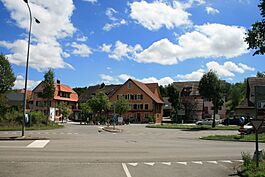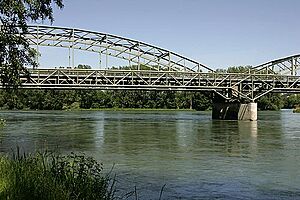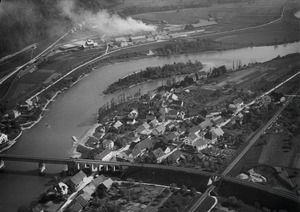Koblenz, Switzerland facts for kids
Quick facts for kids
Koblenz
|
||
|---|---|---|
 |
||
|
||
| Country | Switzerland | |
| Canton | Aargau | |
| District | Zurzach | |
| Area | ||
| • Total | 4.08 km2 (1.58 sq mi) | |
| Elevation | 319 m (1,047 ft) | |
| Population
(Dec 2020 )
|
||
| • Total | 1,671 | |
| • Density | 409.6/km2 (1,060.8/sq mi) | |
| Postal code |
5322
|
|
| Surrounded by | Klingnau, Küssaberg (DE-BW), Leuggern, Rietheim, Waldshut-Tiengen (DE-BW) | |
Koblenz is a small town and a municipality in Switzerland. It's located in the Aargau canton, within the Zurzach district. The town is famous for being where two important rivers, the Aare and the Rhine, meet.
Contents
History of Koblenz
Early History and Roman Times
Koblenz was first mentioned a very long time ago, around the 10th or 11th century. Its name, Confluentia, means "where rivers meet." This is because the Aare and Rhine rivers join together here.
During the time of the Roman Empire, there was a goods yard and watchtowers along the Rhine river in this area. One of these old Roman watchtowers is still standing and is considered a very important historical site in Switzerland. People have lived in Koblenz since the Middle Ages.
Boatmen and Trade
For a long time, the boatmen from Koblenz had a special right to transport goods. They were the only ones allowed to carry items downstream from the important market town of Zurzach towards Basel. This was a very important job because the Rhine river had dangerous currents.
The Arrival of Railways
In the 19th century, things changed when the railway arrived. Trains could carry goods much faster and safer than boats. Because of this, Koblenz and Zurzach lost their main way of making money from river transport.
Geography of Koblenz
Koblenz covers an area of about 4 square kilometers (1.6 square miles). A large part of this land, about 41%, is used for farming. Forests cover almost 30% of the area. About 20% of the land has buildings and roads.
The town is located between the Aare and Rhine rivers. It sits across from the town of Waldshut-Tiengen in Germany. Koblenz is a haufendorf village, which means it's an old village that grew without a clear plan, with houses built close together around a central area.
Koblenz is also known as the "Vier-Brücken-Dorf," which means "village of four bridges." This is because two road bridges and two railway bridges cross the Aare and Rhine rivers here. Interestingly, there's another town called Koblenz in Germany that is also located where the Rhine meets another river, the Mosel.
Coat of Arms
The coat of arms for Koblenz shows a golden shield with a wavy blue line across the middle. Above the line, there is a black boat with an oar. Below the line, there is another wavy blue line. This design likely represents the rivers and the town's history with boats.
People of Koblenz (Demographics)
As of 2008, about 29.7% of the people living in Koblenz were from other countries. Most people in Koblenz speak German, which is about 82.4% of the population. The next most common languages are Albanian and Serbo-Croatian.
In 2008, there were slightly more men (53.9%) than women (46.1%) living in Koblenz. The population changes a little each year due to births, deaths, and people moving in or out.
Age Groups
The age groups in Koblenz (as of 2008) are:
- Children (0-9 years old): 9%
- Teenagers (10-19 years old): 13.8%
- Young adults (20-29 years old): 12.8%
- Adults (30-59 years old): 44%
- Seniors (60 years and older): 20.5%
Historical Population
Here's how the population of Koblenz has changed over time:
| Historical population | ||
|---|---|---|
| Year | Pop. | ±% |
| 1803 | 434 | — |
| 1850 | 709 | +63.4% |
| 1900 | 554 | −21.9% |
| 1950 | 882 | +59.2% |
| 1990 | 1,550 | +75.7% |
| 2000 | 1,611 | +3.9% |
Important Heritage Sites
Koblenz has several important historical sites that are recognized as Swiss heritage sites of national importance. These include:
- The Koblenz Aar railway bridge (which is shared with the nearby town of Leuggern).
- The Koblenz–Waldshut Rhine railway bridge.
- The Kleiner Laufen, which is a remaining watchtower from the old Roman border defenses along the Rhine.
Economy and Jobs
In 2005, Koblenz had different types of businesses:
- Primary sector: This includes jobs like farming. There were 16 people working in this sector.
- Secondary sector: This includes manufacturing and construction. There were 367 people working in this sector.
- Tertiary sector: This includes services like shops, offices, and healthcare. There were 230 people working in this sector.
Many people who live in Koblenz travel outside the town for work. In 2000, about 76% of the residents worked in other places. However, many people also travel into Koblenz for work. About 15% of workers used public transportation, and 51% used a private car to get to work.
Religion
According to the 2000 census, the main religions in Koblenz were:
- Roman Catholic: 44.7% of the population.
- Swiss Reformed Church: 27.7% of the population.
A small number of people also belonged to the Christian Catholic Church of Switzerland.
Education
Switzerland has a very good education system. In Koblenz, about 63.6% of adults (aged 25–64) have completed either high school or even higher education, like university. In the 2008/2009 school year, there were 121 students attending primary school in the municipality.
Transport
Koblenz is well-connected by train and has two railway stations:
- Koblenz railway station: This station is served by the Zurich S-Bahn line S36, which connects to Bülach and Waldshut. It's also on the Aargau S-Bahn line S27, linking to Baden and then either Waldshut or Bad Zurzach.
- Koblenz Dorf railway station: This station is closer to the center of the village but has fewer trains stopping there.
See also
 In Spanish: Koblenz (Argovia) para niños
In Spanish: Koblenz (Argovia) para niños








